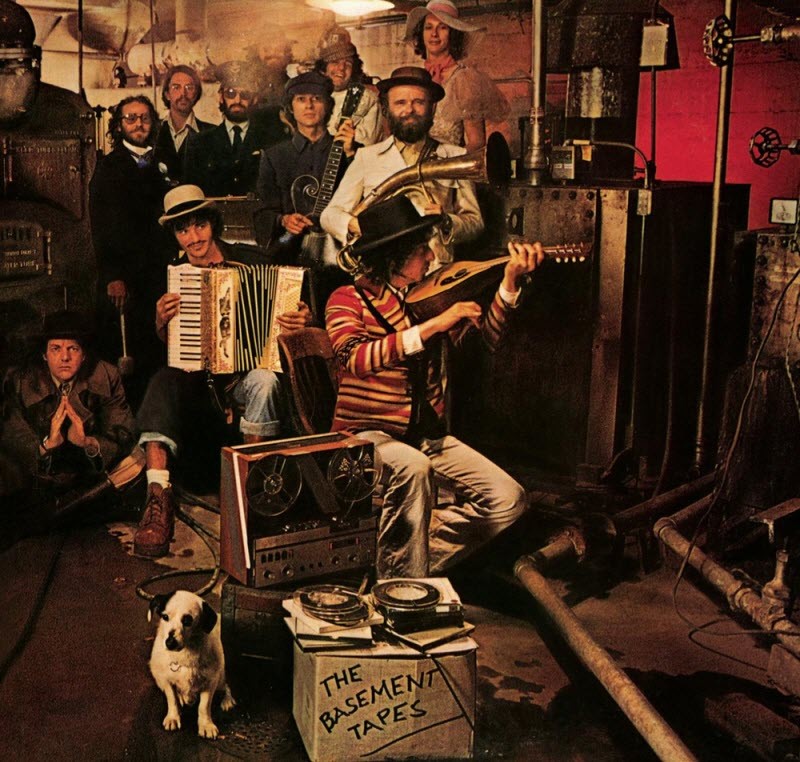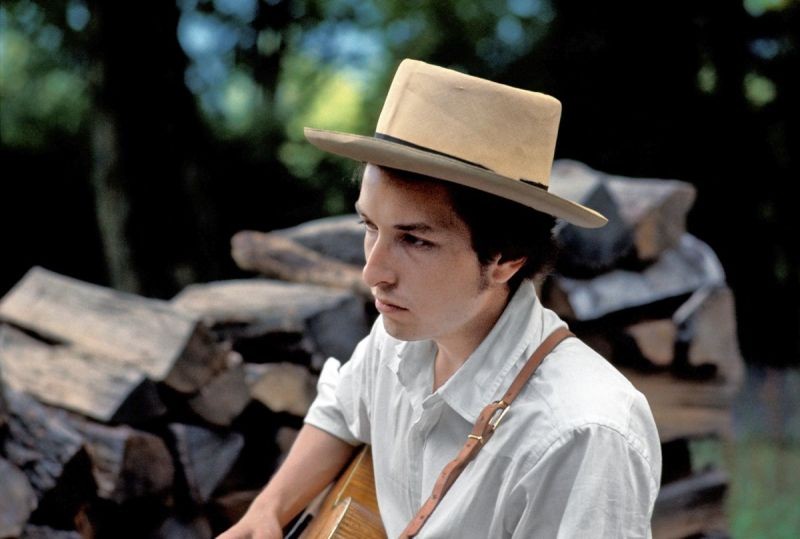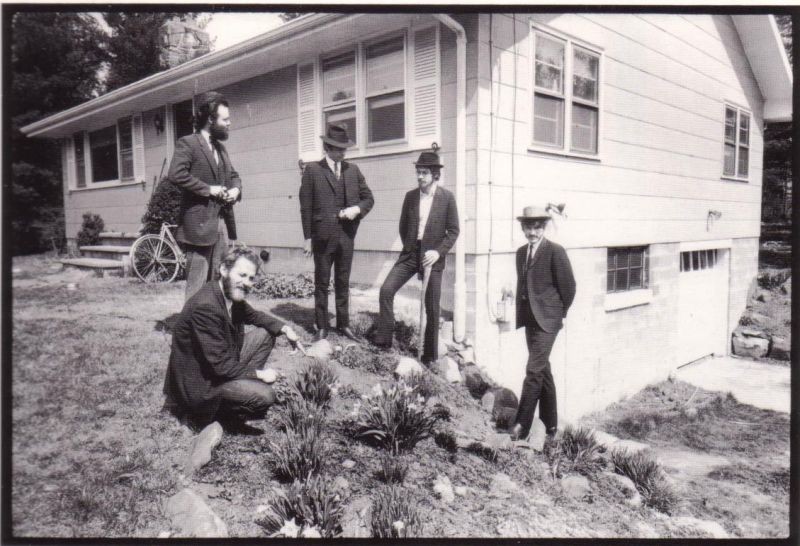
That was recorded in ‘66, ‘67 up in Woodstock, you know, before Woodstock, before the big Woodstock Festival, before Woodstock was discovered, exploited, I don’t know. We were just all up there sort of drying out.
[Mary Travers: You and the Band?]
Yeah. The members of the Band and various other people, up there making music and planting gardens and just watching time go by. So in the meantime we made this record, made this – actually it wasn’t a record, it was just songs which we’d come, you know, to, er, this basement and record; out in the woods. That’s basically it really. Uh, the records have been exposed throughout the years so somebody mentioned it was a good idea to put it out, you know, as a record, so people could hear it in it’s entirety and know just exactly what we were doing up there in those years and it’ll be out shortly.
~Bob Dylan (Mary Travers interview, April 1975)People have told me they think it’s very Americana and all that. I don’t know what they’re talkin’ about.
~Bob Dylan (Kurt Loder interview, March 1984)..Because the Dylan is all work tape, the music is certifiably unpremeditated, lazy as a river and rarely relentless or precise–laid back without complacency or slickness. The writerly “serious” songs like “Tears of Rage” are all the richer for the company of his greatest novelties–if “Going to Acapulco” is a dirge about having fun, “Don’t Ya Tell Henry” is a ditty about separation from self, and both modes are enriched by the Band’s more conventional (“realistic”) approach to lyrics. We needn’t bow our heads in shame because this is the best album of 1975. It would have been the best album of 1967 too. And it’s sure to sound great in 1983. A+
~Robert Christgau (album review in 1975)..John Rockwell in the New York Times declared it “The greatest album in the history of popular American music.” But it wasn”t, and for all the riches within it, all of which are presented out of context, it was a shamefully poor representation of an astonishingly creative, important period in this great artist”s working life.
~Michael Gray (The Bob Dylan Encyclopedia)
“Odds & Ends” @ spotify:
Wikipedia:
| Released | June 26, 1975 |
|---|---|
| Recorded | Dylan – the Band recordings: June–September 1967; the Band only: 1967–1968, later overdubs in 1975 |
| Genre | Roots rock |
| Length | 76:41 |
| Label | Columbia |
| Producer | Bob Dylan, the Band |
The Basement Tapes is a studio album by American singer-songwriter Bob Dylan and the Band, released on June 26, 1975 by Columbia Records. It is Dylan’s sixteenth studio album. The songs featuring Dylan’s vocals were recorded in 1967, eight years before the album’s release, at houses in and around Woodstock, New York, where Dylan and the Band lived. Although most of the Dylan songs had appeared on bootleg records, The Basement Tapes marked their first official release.
When Columbia Records prepared the album for official release in 1975, eight songs recorded solely by the Band—in various locations between 1967 and 1975—were added to sixteen songs taped by Dylan and the Band in 1967. Overdubs were added in 1975 to songs from both categories. The Basement Tapes was critically acclaimed upon release, and reached number seven on the Billboard 200 album chart. Subsequently, the format of the 1975 album has led critics to question the omission of some of Dylan’s best-known 1967 compositions and the inclusion of material by the Band that was not recorded in Woodstock.

The Basement Tapes, they were bootlegged. I didn’t pay much attention to the Basement Tapes. I thought they were what they were – a bunch of guys hanging out down in the basement making up songs.
~Bob Dylan (Denise Worrell, Nov 1985)
Million Dollar Bash @ spotify
In January 1975, Dylan unexpectedly gave permission for the release of a selection of the basement recordings, perhaps because he and Grossman had resolved their legal dispute over the Dwarf Music copyrights on his songs. Clinton Heylin argues that Dylan was able to consent following the critical and commercial success of his album Blood on the Tracks, released that same month: “After Blood on the Tracks, The Basement Tapes no longer had the status of a final reminder of Dylan’s lost genius”. In 1975, as well, the Band purchased Shangri-La ranch in Malibu, California, which they transformed into their recording studio.
Engineer Rob Fraboni was brought to Shangri-La to clean up the recordings still in the possession of Hudson, the original engineer. Fraboni had worked on Dylan’s Planet Waves album, with backing by the Band, and the live Dylan–Band album Before the Flood, both released in 1974. Fraboni has described Robertson as the dominant voice in selecting the final tracks for The Basement Tapes and reported that Dylan was not in the studio very often. The stereo recordings made by Hudson were remixed to mono, while Robertson and other members of the Band overdubbed new keyboard, guitar, and drum parts onto some of the 1967 Woodstock recordings. According to Fraboni, four new songs by the Band were also recorded in preparation for the album’s official release, one of which, a cover of Chuck Berry’s “Going Back to Memphis”, did not end up being included. There is disagreement about the recording date of the other three songs: “Bessie Smith”, “Ain’t No More Cane” and “Don’t Ya Tell Henry”. While Fraboni has recalled that the Band taped them in 1975, the liner notes for the reissued versions of the Band’s own albums state that these songs were recorded between 1967 and 1970. Ultimately, eight of the twenty-four songs on The Basement Tapes did not feature Dylan, several of them studio outtakes postdating the sessions at Big Pink. In justifying their inclusion, Robertson explained that he, Hudson and Dylan did not have access to all the basement recordings: “We had access to some of the songs. Some of these things came under the heading of ‘homemade’ which meant a Basement Tape to us.” Robertson has suggested that the Basement Tapes are, for him, “a process, a homemade feel” and so could include recordings from a wide variety of sources.

..Yeah, like The Basement Tapes. But it doesn’t occur to me to put it out. If I wrote a song three years ago, I seldom go back and get that. I just leave’em alone. I never really liked The Basement Tapes. I mean, they were just songs we had done for the publishing company, as I remember. They were used only for other artists to record those songs. I wouldn’t have put’em out. But, you know, Columbia wanted to put’em out, so what can
you do?
[Kurt Loder: You don’t think that album has a great feeling to it? That material really has an aura.]
I can’t even remember it. People have told me they think it’s very Americana and all that. I don’t know what they’re talkin’ about.
~Bob Dylan (Kurt Loder interview, March 1984)
Clothes Line Saga @ spotify
–
Cover art
The cover photograph for the 1975 album was taken by designer and photographer Reid Miles in the basement of a Los Angeles YMCA. It poses Dylan and the Band alongside characters suggested by the songs: a woman in a Mrs. Henry T-shirt, an Eskimo, a circus strongman and a dwarf who has been identified as Angelo Rossitto. Robertson wears a blue Mao-style suit, and Manuel wears an RAF flight lieutenant uniform. Michael Gray has identified musicians David Blue and Neil Young in the photo. Others have claimed that Young was not in the photo.
–
Track listing
All songs written by Bob Dylan, except where noted.
Side 1
- “Odds and Ends” 1:47
- “Orange Juice Blues (Blues for Breakfast)” (Richard Manuel) 3:39
- “Million Dollar Bash” 2:32
- “Yazoo Street Scandal” (Robbie Robertson) 3:29
- “Goin’ to Acapulco” 5:27
- “Katie’s Been Gone” (Manuel, Robertson) 2:46
Side 2
- “Lo and Behold” 2:46
- “Bessie Smith” (Rick Danko, Robertson) 4:18
- “Clothes Line Saga” 2:58
- “Apple Suckling Tree” 2:48
- “Please, Mrs. Henry” 2:33
- “Tears of Rage” (Dylan, Manuel) 4:15
Side 3
- “Too Much of Nothing” 3:04
- “Yea! Heavy and a Bottle of Bread” 2:15
- “Ain’t No More Cane” (Traditional) 3:58
- “Crash on the Levee (Down in the Flood)” 2:04
- “Ruben Remus” (Manuel, Robertson) 3:16
- “Tiny Montgomery” 2:47
Side 4
- “You Ain’t Goin’ Nowhere” 2:42
- “Don’t Ya Tell Henry” 3:13
- “Nothing Was Delivered” 4:23
- “Open the Door, Homer” 2:49
- “Long Distance Operator” 3:39
- “This Wheel’s on Fire” (Danko, Dylan) 3:52
–
Personnel
- Bob Dylan – acoustic guitar, piano, vocals
- Rick Danko – bass guitar, mandolin, vocals
- Levon Helm – drums, mandolin, bass guitar, vocals
- Garth Hudson – organ, clavinet, accordion, tenor saxophone, piano
- Richard Manuel – piano, drums, harmonica, vocals
- Robbie Robertson – electric guitar, acoustic guitar, drums, vocals

..though revealing in their own right, the Band tracks only pollute the official set and reduce its stature.
~Clinton Heylin[The Songs]..sound like they were made in a cardboard box. I think [Dylan] was trying to write songs that sounded like he’d just found them under a stone. As if they sound like real folk songs—because if you go back into the folk tradition, you will find songs as dark and as deep as these.
~Elvis CostelloListening to The Basement Tapes now, it seems to be the beginning of what is called Americana or alt.country, the thing about alt.country which makes it ‘alt’ is that it is not polished. It is not rehearsed or slick. Neither are The Basement Tapes. Remember that The Basement Tapes holds a certain cultural weight which is timeless—and the best Americana does that as well.
~Billy Bragg
Full album @ spotify
–
Alldylan.com takes us hundreds of hours a month to research and write. If you find any joy and value in what we do, please consider donating.
–
–
Check out:
-Egil

Shalom & Boker tov…Shabtai Zisel / ‘Bob Dylan’ was not especially enamoured with the 1975 effort…and it would have been helpful if you had focused more on the later complete(d) effort by Garth Hudson and his Canadian partners of 2014.
~~~~~~~~~~~~~~~~~~~~~~~~~~~~~~~~~~~~~~~~~
STEPHAN PICKERING / חפץ ח”ם בן אברהם
Torah אלילה Yehu’di Apikores / Philologia Kabbalistica Speculativa Researcher
לחיות זמן רב ולשגשג
THE KABBALAH FRACTALS PROJECT